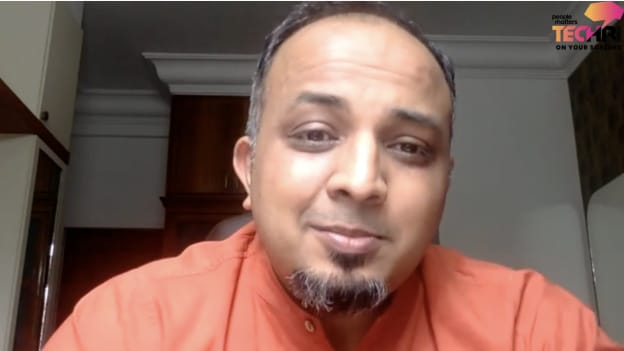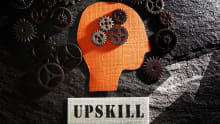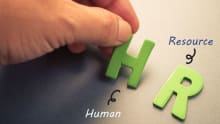Skills Analytics for a future-ready workforce

With changing business needs, the average life of skills is becoming shorter & there is a need for constant upskilling of the workforce to be future-ready. Organizations must learn to leverage the power of skills analytics to identify the skill gaps & devise targeted learning strategies. It is already established that data plays a key role in business survival and success today. With business analytics at the forefront of today’s enterprise, organizations are using more and more data to make decisions, have that competitive advantage and use it for reaching their goals, to avoid ineffective guesswork.
In his session at People Matters TechHR 2021, Bhavin Patel, Sales Director, Degreed shed light on how organizations can leverage skill analytics for building a future-ready workforce.
53% of HR leaders say the inability to identify needed skills is the biggest impediment to workforce transformation.
Why skill analytics?
Skill data is the newest addition for performance enhancement to enable better decisions around talent transformation or talent development. Skill analytics should be at the heart of business strategy, since there is a proven positive correlation between insight-driven culture and business performance.
Organizations that wish to benefit from digital transformation or a promising new strategy won’t get very far if they lack the people to bring the plans to life. What might seem like a small talent gap today could prove a fatal competitive liability tomorrow. Hence, talent management teams must work closely with business to identify the skill gaps and work on them. The question is, where to start the skills analytics journey?
How to kickstart the skills analytics journey?
HR leaders must first begin by asking themselves, “Are we talking in the same language as business?” The answer lies in how the business communicates the need and how the talent teams build solutions around it. Businesses typically talk about outcomes, while HR builds models on behavioural shifts. Traditionally both converge, but only at a point with a huge time gap. To act with speed, HR must have more real-time visibility into what are the gaps and how to address them. As the rate of business change increases, HR needs to catch up. Understanding and communicating the business needs well, is therefore, the key to staying ahead of business disruptors.
Shifting focus on skills versus competencies
If business is looking for agility and adaptive responsiveness to address shifting demands, skills must be developed in-line, to enable lasting action and results. This requires a shift from competencies to skills. Competencies are usually comprised of 4 key components:
- Knowledge: Can be learned and measured and are objective.
- Skills: Can be learned and measured and are objective.
- Attributes: Talks about ‘who you are’ and rarely changes due to a lot of subjectivity and bias built into observations.
- Behaviours: Hard to learn, can be modified but require more discipline and attention to see significant changes. Behaviours are usually subjectively valued by managers.
As the business requirement changes, the competency model needs to change. The caveat for competencies lies in the fact that it is easy and possible to help someone build and activate knowledge and skills, but not so easily attributes and behaviours. This makes the competency model difficult to keep pace with business needs and difficult to align with the values, vision and mission. On the other hand, skills map better with desired outcomes, allowing for a pragmatic development that produces desired results:
The skills-approach, on the contrary, is centred around the below three tenets:
- Curating the learning experience: Skills can be developed and measured. Organizations need to build the right development focus to build and assess employee skills required for them to perform well in their current roles and progress their work. The desired outcome is to Learn More. Employees learn more because the focus on skills helps them perform better and advance their careers.
- Creating the skills activation experience: Skills can be activated and advanced easily. Organizations must provide opportunities for employees to practice, stumble, recover and perfect skills while they work. The desired outcome from this step is to Grow Faster because employees apply their skills through real work experiences.
- Enabling the analytics-insights experience: Skills are transactable, transferrable and objective. This focus will provide insights and intelligence about one’s skill supply, skill movement, and skill velocity to drive business outcomes. The desired outcome from this step is to Show Results. Dynamic skill data helps see the results of development efforts so as to make better business decisions
All these three experiences must be embedded into charting out the organizational learning plans. For this, L&D must build an ecosystem that supports the learning experience, maybe in forms such as mentoring, stretch assignments, etc. Such immersive experiences will help employees not only learn new skills, but also build confidence in their newly learnt skills. This is an iterative process that demands ongoing leadership commitment.
How does the skills framework transpire to business results?
A skills enablement journey must be built through the following four stages:
- Development through Knowledge Acquisition and Assessment: L&D must improve the efficiency of learning development and learning delivery by amplifying employee engagement in learning.
- Skills Activation through skill data, analysis and insights: L&D must improve learning effectiveness by integrating learning experiences in the everyday flow of work. This will help accelerate the velocity of skills shift.
- Mobility through talent planning and workforce deployment: HR must enable employees to transact on skills and experience. Programs must be designed to facilitate career progression. A starting point is to identify talent readiness for workforce deployment and proactively plan for movement of talent based on strategic needs. This will help in reducing dependencies on external hires.
- Organizational effectiveness and durability through workforce planning, organizational design, organizational performance enablement: Democratizing HiPo identification & development and amplifying succession planning & leadership effectiveness are critical to skills success. HR and business leaders as a whole must enable an inclusive and high performing culture for driving organizational effectiveness.
Such a four-pronged skills strategy must be curated by analysing data points. This will open up a lot of opportunities to solve business problems faster. Skills are at the epicentre of everything in a knowledge economy, where people are the prime driver of competitive advantage. A targeted skills strategy will help fuel careers and drive employee retention and engagement.






